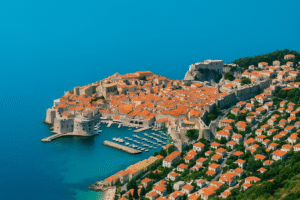As it was discussed in a previous article, Africa’s distribution sector is evolving rapidly — shaped by urban expansion, increased intra-continental trade, and rising investments in infrastructure and technology.
At Weitnauer Group, we bring deep local expertise across the distribution chain — from market entry to brand training and retail execution. When approached by premium brands exploring African market entry, we responded by conducting on-the-ground visits across East and West Africa, combined with targeted market research. One key insight remains clear: Africa is not a monolith. Unlocking its potential requires pinpointing the continent’s fastest-growing logistics hubs.
In this guide, we’ll spotlight top-performing Africa Global Logistics Hubs countries in each category, examine overlaps, and highlight where B2B distribution — especially for premium and luxury brands — has the strongest growth potential.
Key Parameters for Evaluating Market Entry in African Logistics
When evaluating market entry opportunities for B2B distribution in Africa, it’s crucial to focus on three core parameters:
- Logistics Performance Index (LPI):
The LPI, developed by the World Bank, measures the efficiency of customs, the quality of trade and transport infrastructure, and the competence of logistics services. A high LPI score indicates a country’s ability to support reliable, fast, and cost-effective supply chains—vital for B2B operations.
- GDP (Gross Domestic Product):
GDP reflects the size and health of a country’s economy. High or rapidly growing GDP signals a robust market with increasing demand for goods and services, making it attractive for distributors seeking scale and long-term growth.
- Luxury Brands Entry
As highlighted in our previous article, Weitnauer Group overlook the ‘Luxury Brand Entry’ to assess the maturity and potential of emerging markets. The presence of high-end brands is more than symbolic — it reflects rising disposable income, evolving consumer preferences, and infrastructure capable of supporting premium retail.
Luxury brand success serves as a proxy for:
- A growing upper-middle class
- Reliable retail and logistics networks
- Consumer readiness for premium, specialized products
By combining three key indicators — Logistics Performance Index (LPI), GDP growth, and Luxury Brand Entry — distributors gain a comprehensive framework for evaluating investment opportunities across Africa’s complex and varied markets.
This approach enables more precise, data-driven decisions on where to expand, when to enter, and how to scale across the continent.
Top 3 African Countries in each Subregion by Logistics Performance Index (LPI)
Based on the latest available World Bank LPI data and your request, here are three top-performing countries by Logistics Performance Index (LPI) in each African subregion. This approach highlights regional leaders, while the 2018 and 2023 LPI data sheds light on the most promising regions for future growth.
North Africa
| Country | LPI Score (2023) | LPI Score (2018) | Change |
| Egypt | 3.1 | 2.82 | – |
| Morocco | – | 2.54 | – |
| Algeria | 2.5 | 2.45 | + 0.05 |
- Egypt leads the region with strong logistics capabilities centered on the Suez Canal, large-scale port developments, and strategic trade corridors.
- Morocco shows notable improvements in customs and port logistics, particularly around Casablanca and Tangier.
- Algeria remains a developing player, with recent efforts to streamline customs and modernize infrastructure.
West Africa
| Country | LPI Score (2023) | LPI Score (2018) | Change |
| Benin | 2.9 | 2.75 | + 0.15 |
| Côte d’Ivoire | – | 3.08 | – |
| Ghana | 2.7 | 2.57 | + 0.13 |
- Benin and Côte d’Ivoire are praised for efficient port operations and expanding trade facilitation programs.
- Ghana continues to invest in logistics corridors such as the Tema-Mpakadan railway and improvements in inland clearance processes.
East Africa
| Country | LPI Score (2023) | LPI Score (2018) | Change |
| Kenya | 2.81 | – | |
| Rwanda | 2.7 | 2.97 | -0.27 |
| Djibouti | 2.7 | 2.63 | +0.07 |
- Kenya acts as the regional anchor, supported by the Port of Mombasa and the Standard Gauge Railway.
- Rwanda stands out for its digital-first approach to customs and logistics reform.
- Djibouti leverages its geostrategic port infrastructure as a transshipment hub for the Horn of Africa and Ethiopia.
Central Africa
| Country | LPI Score (2023) | LPI Score (2018) | Change |
| Cameroon | 2.1 | 2.6 | -0.5 |
| Congo (Rep.) | 2.6 | 2.49 | + 0.11 |
| Gabon | 2.4 | 2.16 | + 0.24 |
- Congo (Rep.) and Gabon outperform regional peers in port and customs efficiency.
- Cameroon is investing in trade corridors but continues to face structural and operational constraints.
Southern Africa
| Country | LPI Score (2023) | LPI Score (2018) | Change |
| South Africa | 3.7 | 3.38 | +0.32 |
| Botswana | 3.1 | – | – |
| Namibia | 2.9 | – | – |
- South Africa remains Africa’s top logistics performer, with world-class ports, rail systems, and warehouse capacity.
- Botswana is an emerging leader, known for efficient cross-border processes and a stable business environment.
- Namibia, anchored by the Port of Walvis Bay, plays a key role in supporting landlocked neighbors across Southern and Central Africa.
Key Takeaway: Africa LPI Outlook
Africa’s logistics environment is regionally diverse and shifting fast:
- Southern Africa offers the strongest infrastructure foundation today.
- West and North Africa are the fastest improving regions, increasingly attractive for near-term expansion.
- East Africa remains stable, with Kenya and Djibouti central to regional connectivity, while internal performance gaps warrant close monitoring.
- Central Africa remains the most challenging, but with growing bright spots.
For B2B logistics and distribution leaders, these trends provide the clarity to not only choose the right markets but also anticipate where competitive advantage is forming next.
Top 3 African Countries in each Subregion by GDP growth rate
Next, we turn to economic performance as a key indicator of distribution opportunity. By reviewing GDP growth rates and GDP in the same countries and subregions covered earlier, we can assess how economic momentum aligns or diverges from logistics infrastructure and market readiness.
North Africa – Steady and Diversified Growth
| Country | 2025 | 2024 | 2023 |
| Morocco | 4.8 | 3.7 | – |
| Algeria | – | 4.2 | 2.3 |
| Egypt | 4.77 | 4.3 | – |
| Country | GDP 2024 (USD Billion) |
| Egypt | 389.0 |
| Algeria | 264.0 |
| Morocco | 154.0 |
North Africa is some of Africa’s largest economies with stable mid-single-digit growth.
- Egypt ($389B) and Morocco ($154B) lead in both size and logistics maturity.
- Growth in 2025 remains steady: Morocco (4.8%), Egypt (4.77%), Algeria (4.2% in 2024).
- The region benefits from economic diversification, energy exports, and expanding trade infrastructure.
- Strategic Fit: Ideal for scalable distribution and long-term investment, with strong foundations already in place.
West Africa – Rapid Acceleration
| Country | 2025 | 2024 | 2023 |
| Benin | – | 14.4 | 7.3 |
| Côte d’Ivoire | – | 6.5 | – |
| Ghana | 5.3 | 3.6 | – |
| Country | GDP 2024 (USD Billion) |
| Ivory Coast | 86.54 |
| Ghana | 82.83 |
| Benin | 21.48 |
West Africa is one of the fastest-growing regions in Africa, with strong momentum driven by infrastructure investment, energy development, and regional trade integration.
- Benin leads with exceptional growth: 14.4% in 2024 from a low base ($21.5B GDP).
- Côte d’Ivoire (6.5%) and Ghana (5.3%) also show solid expansion, backed by mid-sized economies: $86.5B and $82.8B respectively.
- Strategic Fit: Attractive for high-growth market entry and early-stage distribution, especially in consumer and logistics-driven sectors.
East Africa – The Growth Engine
| Country | 2025 | 2024 | 2023 |
| Rwanda | 7.8 | 8.0 | – |
| Djibouti | 6.8 | 7.5 | – |
| Kenya | 4.8 | 5.1 | – |
| Country | GDP 2024 (USD Billion) |
| Kenya | 124.0 |
| Rwanda | 14.25 |
| Djibouti | 4.09 |
East Africa stands out for its consistent and high GDP growth, supported by agriculture, digital infrastructure, and logistics development.
- Rwanda (7.8%) and Djibouti (6.8%) show strong policy-driven growth, though from smaller GDP bases: $14.3Band $4.1B.
- Kenya, the regional anchor, combines scale ($124B GDP) with solid growth (4.8%).
- Strategic Fit: Ideal for scalable B2B models, regional trade, and long-term expansion into high-growth, improving markets.
Central Africa – Resource-Fueled Recovery
| Country | 2025 | 2024 | 2023 |
| Congo (Rep.) | – | – | 6.2 |
| Gabon | – | 3.2 | 2.4 |
| Cameroon | – | 3.1 | 3.7 |
| Cameroon | 51.33 |
| Gabon | 20.87 |
| Congo (Rep.) | 15.72 |
Central Africa shows moderate and uneven growth, primarily driven by mineral exports and resource-linked recovery.
- Gabon and Cameroon posted modest growth in 2024 (3.2% and 3.1%), while Congo (Rep.) showed stronger performance in 2023 (6.2%).
- Economies remain relatively small: Cameroon ($51.3B), Gabon ($20.9B), Congo Rep. ($15.7B).
- Strategic Fit: Suitable for long-term, sector-specific distribution (e.g., industrial goods, energy), with growth tied closely to commodity cycles.
Southern Africa – The Most Cautious Outlook
| Country | 2025 | 2024 | 2023 |
| Namibia | 2.7 | 3.6 | – |
| South Africa | 0.8 | 0.8 | – |
| Botswana | -0.3 | -2.0 | – |
| Country | GDP 2024 (USD Billion) |
| South Africa | 400.0 |
| Botswana | 19.4 |
| Namibia | 13.37 |
Southern Africa features Africa’s largest economy but also the weakest regional growth.
- South Africa leads in scale ($400B GDP) but continues to stagnate at 0.8% growth.
- Botswana remains in contraction (-0.3%), while Namibia shows some resilience (2.7%) despite its smaller size ($13.4B).
- Strategic Fit: Best suited for mature market strategies and efficiency-focused operations, rather than aggressive expansion.
Bottom Line
- Biggest economy: South Africa – but with the slowest growth
- Fastest-growing: Benin – but among the smallest economies
- Most balanced: North Africa – high GDP with stable growth
- Best growth consistency: East Africa
- Lowest GDP + modest growth: Central Africa – emerging from a low base

Top 3 African Countries for Luxury Brand Entry
The presence and growth of luxury brands are strong indicators of a market’s readiness for high-value distribution. According to the Africa Luxury Market Analysis that we conducted previously, three countries stand out:
- South Africa: The undisputed leader in luxury retail, South Africa’s Johannesburg and Cape Town are home to flagship stores for global luxury brands. The country’s sophisticated consumer base and advanced retail infrastructure make it the top choice for high-value distribution.
- Egypt: With a rapidly growing luxury market, especially in Cairo and Alexandria, Egypt is attracting international brands and expanding its premium retail footprint. The country’s rising middle class and tourism sector support demand for luxury goods.
- Morocco: Casablanca and Marrakech are emerging as luxury destinations, with a growing number of international brands entering the market. Morocco’s blend of tradition and modernity appeals to both local consumers and tourists seeking premium experiences.
These countries demonstrate the infrastructure, consumer demand, and market sophistication necessary for successful luxury and high-value B2B distribution.
Africa global logistics Hubs: Who Are the Overall Winners?
Southern Africa, led by South Africa, remains the continent’s most advanced logistics and luxury retail hub, its economic growth is stable or declining, which may limit near-term expansion opportunities.
West and East Africa are emerging as dynamic growth regions. They combine improving infrastructure with fast-growing economies and expanding trade ecosystems — creating fertile ground for B2B distribution. For distributors, the greatest long-term opportunities lie in aligning the reliability of established markets with the momentum of rising ones. The winners will be those who scale not just where infrastructure is ready — but where demand is accelerating.
At Weitnauer, our distribution services span nearly 30 countries across West and East Africa, anchored by regional hubs in Kenya and Côte d’Ivoire. These offices serve as operational and strategic centres, with dedicated local teams supporting 13+ countries in each cluster. Our on-the-ground presence enables us to deliver tailored solutions, respond quickly to market needs, and build long-term value across some of Africa’s most dynamic regions.
Related Articles
.


